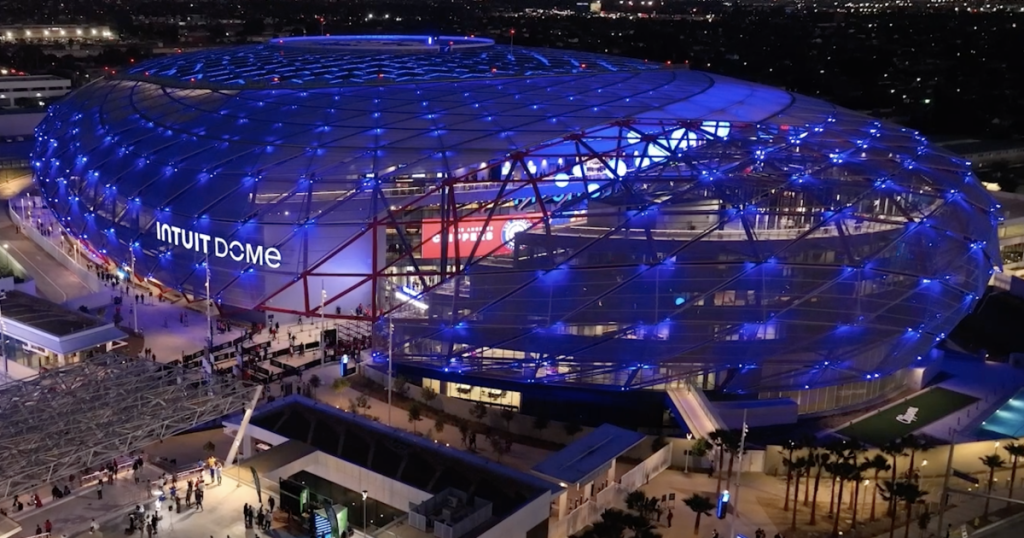The future of checkout is eliminating checkout entirely, a task that has thus far eluded the payments industry.
One of the latest attempts is at theIntuit Dome, a new arena that is using mobile technology to power shopping and payments without a point of sale.
For banks, payment companies and other firms that sell technology to merchants, the Los Angeles arena’s level of success will provide a high-profile view into consumer demand for “
“The checkout process is by definition friction. The ability to eliminate lines and friction especially at live events is a potentially big win,” Tony DeSanctis, a senior director at Cornerstone Advisors, told American Banker. “The question remains how seamless and efficient the process is for the end consumer and whether there is any loss to the merchant associated without a formal checkout process.”
Payment dome
The Intuit Dome, which opened for the 2024-25 NBA season, is an example of invisible payments at scale. Uber, which automatically charges riders’ accounts after a trip, has provided the most well-known example of invisible payments and has served as an
In-store invisible payments include Amazon Go and other in-store versions of
Instead of focusing specifically on avoiding checkout or a purpose-built store with new point of sale terminals, the Intuit Dome is positioning the technology as part of a broader experience where concessions are just one component. The arena also features a range of indoor and outdoor spaces,
While checkout-free retail can speed processing and marketing while reducing lines, there’s also fraud risk. User identity for Intuit Dome and similar checkout-free venues is tied to the app login, making authentication similar to any
But that makes checkout-free payments similar to costly card-not-present sales, which carry higher fees. While checkout-free retail happens inside a store, the actual payment is charged to an app. That’s similar to an e-commerce payment, creating tricky negotiations among technology providers, stores and card networks.
“If checkout-free purchases can be mastered in these settings while keeping fraud to a minimum, they can be used anywhere,” Debbie Buckland, an analyst at Gartner, told American Banker.
At the Intuit Dome, checkout-free payments is also a way to study how people engage the arena, providing data that can be used to inform incentive marketing, inventory management and product positioning.
“We know what you bought and what you looked at and what you didn’t buy,” George Hanna, chief technology officer and digital officer for the Los Angeles Clippers and the Intuit Dome, told American Banker. “That can help with learning.”
That data can also support payment routing, or
The Clippers say checkout times have improved about 800% over the manual concessions it was using before the new arena opened.
“There’s no registers, no cashiers. You just ID yourself and walk in,” Hanna said. “It’s much better than ‘belly up’ concessions that have cashiers. It’s our goal to get you back to the seats.”
The Clippers’ partner, technology developer and consultant Globant, which has worked with Delta Airlines and Disney on embedded “check in” with shopping and payments, is applying the “just walk out” concept to a broader experience than a store. That can boost user habits more than an experimental or purpose-built store because the mix of large crowds and multiple functions is more like the real world than a test store, Tania Salarvand, a managing director at Globant, told American Banker.
“This is not just about one touchpoint,” she said.
Lots of competitors
Given its ability to add speed and product troves of actionable data, along with its unfulfilled promise, checkout-free retail has attracted lots of providers.
Besides Amazon Go, firms like Grabango, Zippin and AiFi have built checkout-free technology. Zippin has provided checkout technology for Nissan Stadium in Nashville. Zippin has also partnered with Mastercard to support payments for Mastercard’s Shop Anywhere platform.
Mastercard rival Visa has made the Olympics and other sports festivals a testing ground for
“Sporting events are places where people are showing up in droves,” Nico Avila, chief technology officer for North American at Globant, told American Banker. “They get used to an easy experience and want to have that elsewhere.”
Across banking and merchant technology, invisible payments will continue to grow in importance as consumers demand quick, seamless shopping experiences, Buckland said. “Just as a retail shopping site should know my product preferences, they should also know my payment preferences based on past behavior.”
While a digital wallet or merchant retail account may have three payment methods saved, consumers often use one credit card for high dollar purchases, a debit card for subscription payments and a bank account for transactions under $100.
“When I fill my cart and click buy, the retailer should know which payment method to use based on set preferences and previous behavior,” Buckland said. “If a decision between two payment methods is too close to call, the default method should be applied.”
It will take some regulatory changes for using past behavior to automatically inform a future payment, without manual preference setting or authorization, according to Buckland. “The technology exists today, unfortunately regulations permitting this need to catch up.”
